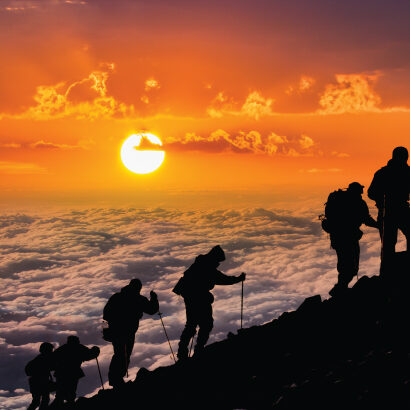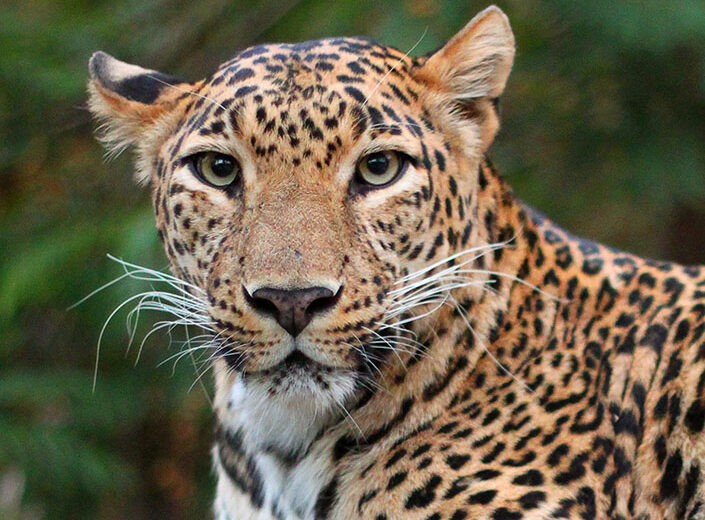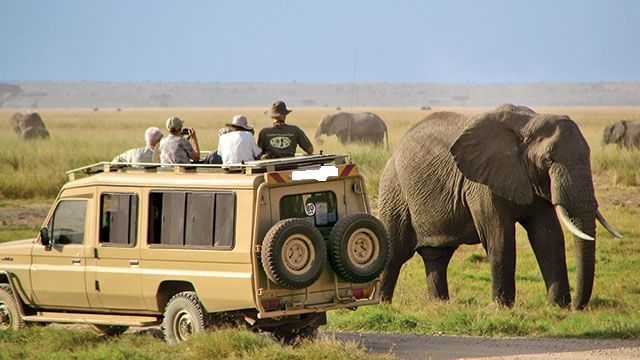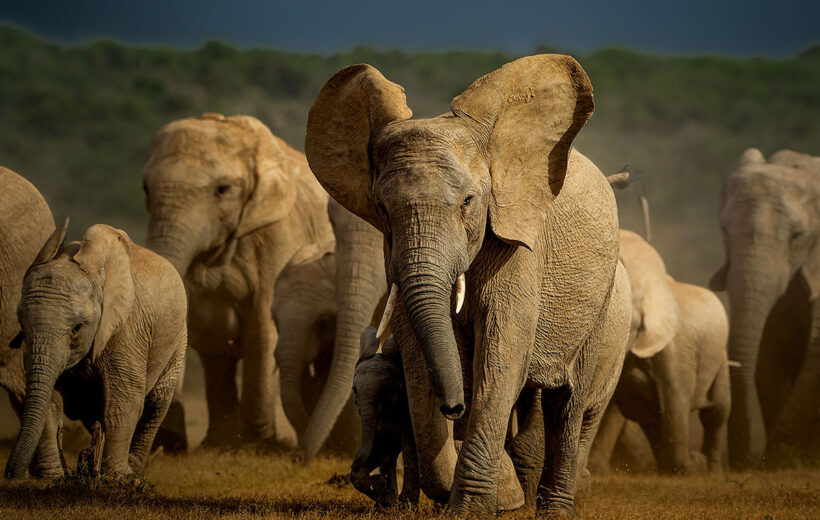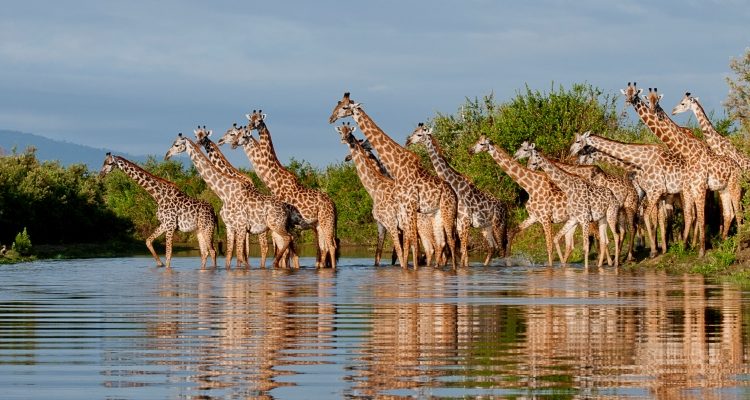Ruaha National Park
Ruaha National Park
Ruaha National Park: Tanzania's Hidden Gem
Nestled in the heart of Tanzania, Ruaha National Park remains one of the country's best-kept secrets and an unspoiled gem for those who discover it. This vast, rugged wilderness offers a remarkable safari experience for wildlife enthusiasts and adventurers alike.
Geography and Size: Ruaha National Park, located in south-central Tanzania, is the largest national park in the country. Covering approximately 20,226 square kilometers (7,809 square miles), it is larger than some small countries. The park's landscape is diverse, featuring rolling hills, rocky outcrops, and the Great Ruaha River that flows through the park. These geographical features make Ruaha an enticing destination for both wildlife and landscape photographers.
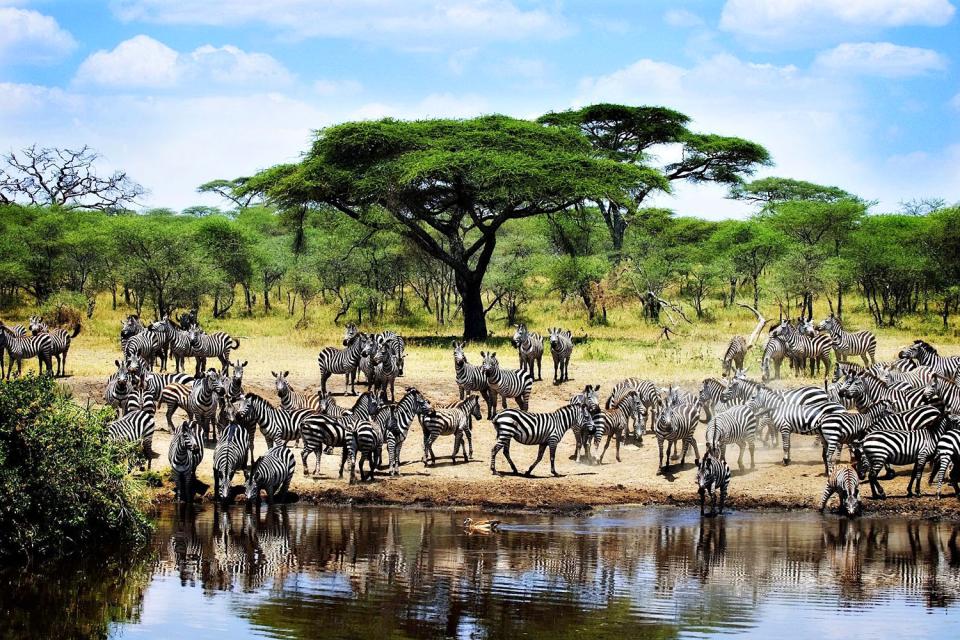
Key features of Ruaha National Park
-
-
Wildlife Abundance: Ruaha is renowned for its thriving and varied wildlife populations. Visitors can expect to encounter a plethora of animals, including large herds of elephants, buffaloes, giraffes, and various antelope species. Predators like lions, leopards, cheetahs, and hyenas are abundant, offering captivating opportunities for game viewing. It's also home to an impressive array of birdlife, making it a paradise for birdwatchers.
The Great Ruaha River: The Great Ruaha River is the lifeblood of the park, providing water and sustenance for the multitude of animals that rely on it. The riverbanks are bustling with hippos and crocodiles, and the river is a source of mesmerizing wildlife interactions, especially during the dry season when animals gather around its banks.
Scenic Beauty: The park's landscapes are diverse and striking. Rocky hills, open savannas, and forests of acacia and baobab trees create an ever-changing backdrop for wildlife photography. The majestic baobabs, with their colossal trunks and unique silhouettes, are a favorite subject for photographers. The undulating terrain provides breathtaking vistas, especially as the sun sets over the vast savannas.
-
Best Time to Visit
- Overview
- Things To Do
- Dry Season
- Birdwatching
- Cultural Experiences
- Avoiding Crowds
- Accommodation
- How To Get There
The best time to visit Ruaha National Park in Tanzania depends on your interests and what you hope to experience during your safari. Here are the primary considerations for the best times to visit Ruaha National Park:
-
Dry Season (June to October):
- June to October is considered the prime safari season in Ruaha. During this period, the weather is generally dry, and the vegetation is less dense. The cooler and drier conditions make it an excellent time for wildlife viewing.
- The concentration of wildlife around water sources, such as the Great Ruaha River, makes animal sightings more predictable and frequent.
-
Wildlife Viewing:
- If you’re primarily interested in wildlife viewing, the dry season offers the best opportunities. The reduced vegetation makes it easier to spot animals, and the chance of witnessing predator-prey interactions is higher.
-
Birdwatching:
- Ruaha National Park is a superb birdwatching destination. Bird enthusiasts may prefer the wet season (November to April) when migratory bird species arrive, but birdwatching is rewarding year-round.
-
Scenery and Landscape:
- The park undergoes a dramatic transformation during the wet season (November to April). Lush green landscapes, wildflowers in bloom, and vibrant scenery can be more appealing to photographers and those who appreciate the beauty of the rainy season.
-
Fewer Crowds:
- The park is less crowded during the wet season, making it a preferred choice for those seeking a quieter and more exclusive safari experience.
-
River Activities:
- If you’re interested in river activities like boat safaris, the best time is during the dry season when water levels are lower and the river is more navigable.
-
Fishing:
- Fishing enthusiasts may prefer the dry season when river and lake water levels are lower, making it easier to catch certain fish species.
-
Night Sky Viewing:
- The dry season offers clearer night skies for stargazing and astrophotography due to reduced cloud cover.
Ultimately, the best time to visit Ruaha National Park depends on your specific interests. Whether you prioritize wildlife viewing, birdwatching, the unique landscapes of each season, or a quieter safari experience, planning your visit accordingly will help you make the most of your time in this remarkable and less-visited national park in Tanzania.
Ruaha National Park in Tanzania offers a wide range of activities and experiences for safari enthusiasts. Here are some of the top things to do in Ruaha National Park:
-
Game Drives: Game drives are the primary activity in Ruaha National Park. Experienced guides take you on thrilling drives through the park to spot a diverse array of wildlife, including elephants, lions, leopards, cheetahs, giraffes, and more.
-
Birdwatching: Ruaha is a paradise for birdwatchers, with over 570 bird species. Bring your binoculars and explore the park to spot various raptors, waterfowl, and colorful songbirds.
-
Walking Safaris: Guided walking safaris offer a chance to explore the park on foot, immersing yourself in the smaller details of the ecosystem, tracking animals, and learning about the flora and fauna up close.
-
Night Drives: Night safaris are an exciting way to observe nocturnal animals and predators on the hunt. You might see leopards, hyenas, and smaller creatures that come alive after dark.
-
Boat Safaris: Along the Great Ruaha River, boat safaris provide a unique perspective of the park and offer close encounters with hippos, crocodiles, and various water birds.
-
Photography: The park’s stunning landscapes and diverse wildlife make it an excellent destination for photography. Capture the beauty of the African wilderness, from breathtaking sunsets to close-up shots of wildlife.
-
Cultural Experiences: Engage with local communities outside the park for cultural interactions. Learn about traditional customs, dances, and daily life, and visit local villages to connect with the indigenous people.
-
Bush Breakfasts and Sundowners: Some lodges offer the chance to enjoy breakfast in the bush or sundowners with panoramic views of the park. These experiences provide a unique blend of nature and luxury.
-
Conservation Activities: Some lodges and organizations offer conservation activities, including tree planting and other initiatives. Participating in such activities can contribute to the park’s long-term preservation.
-
Fly Camping: For the adventurous, try fly camping, which involves setting up temporary camps in the wilderness, allowing you to immerse yourself in the natural surroundings.
-
Stargazing: With minimal light pollution, Ruaha National Park offers excellent stargazing opportunities. The clear night skies are perfect for astronomy enthusiasts.
-
Scenic Flights: Take a scenic flight over the park to appreciate its vastness and diverse landscapes from the air. This is a fantastic way to capture the beauty of the park in its entirety.
-
Walking Trails: Explore the designated walking trails within the park, which allow you to discover the park’s natural beauty at your own pace.
Ruaha National Park offers a blend of traditional game drives and unique experiences, making it an excellent destination for an African safari adventure. Whether you’re interested in wildlife encounters, cultural interactions, or adventure activities, Ruaha has something to offer every traveler.
The dry season in Ruaha National Park is a time of contrasting landscapes and extraordinary wildlife encounters. This season typically occurs from June to October and offers a unique set of features and experiences that make it an ideal time for safari enthusiasts. Here’s what you can expect during the dry season in Ruaha National Park:
-
Pleasant Weather: The dry season is characterized by mild temperatures and minimal rainfall. Days are warm, and the nights can be cooler, making it comfortable for outdoor activities like game drives.
-
Reduced Vegetation: With less rainfall, the park’s vegetation begins to thin out, revealing clearer sightlines. The sparse foliage allows for better wildlife visibility, as animals often congregate around remaining water sources.
-
Abundant Wildlife: Wildlife viewing is exceptional during the dry season. The scarcity of water sources compels animals to gather around the Great Ruaha River, where you can witness large herds of elephants, buffaloes, and other species quenching their thirst. Predators such as lions, leopards, and cheetahs are also more active during this time, making it an excellent period for predator sightings.
-
Birdwatching: Although the dry season is generally considered better for big game viewing, Ruaha National Park is a year-round birdwatching destination. Resident and migratory bird species can be observed, making it a great time for bird enthusiasts.
-
Photography: The reduced vegetation allows for clearer and more unobstructed photography of both wildlife and landscapes. The golden savannah and distinct wildlife silhouettes make for striking photographs.
-
River Activities: Boat safaris along the Great Ruaha River are more popular during the dry season when the river is narrower and water levels are lower. This allows for up-close encounters with hippos, crocodiles, and a variety of waterfowl.
-
Night Sky Viewing: With fewer clouds during the dry season, the night skies in Ruaha National Park are perfect for stargazing and astrophotography. The lack of light pollution in this remote area provides exceptional views of the stars.
-
Fewer Insects: The dry season is associated with fewer insects, including mosquitoes, making for a more comfortable and insect-free safari experience.
While the dry season is an excellent time for wildlife enthusiasts, it’s worth noting that Ruaha National Park is a year-round destination with its own unique charm during the wet season when lush landscapes and migratory bird species arrive. Therefore, the choice of when to visit depends on your specific interests and priorities.
-
Birdwatching in Ruaha National Park is a rewarding and captivating experience, as this Tanzanian wilderness is home to an astonishing variety of bird species. With its diverse habitats, including open plains, riverine forests, wetlands, and miombo woodlands, Ruaha offers a rich tapestry of avian life. Here’s what you need to know about birdwatching in Ruaha National Park:
Bird Diversity: Ruaha is known for hosting over 570 bird species, making it a haven for both amateur and seasoned birdwatchers. From vibrant kingfishers and raptors to the smaller but equally striking sunbirds and weavers, Ruaha’s birdlife is an ever-changing spectacle.
Birding Hotspots:
-
Great Ruaha River: The river and its surrounding areas provide excellent birdwatching opportunities. Keep an eye out for water-associated species such as fish eagles, storks, herons, and African skimmers.
-
Wetlands: The park’s wetlands and seasonal lakes attract a variety of waterfowl, including flamingos, pelicans, and a myriad of waders.
-
Riverine Forests: These lush areas are habitat to unique bird species like the white-fronted bee-eater, African paradise flycatcher, and purple crested turaco.
-
Miombo Woodlands: Ruaha’s miombo woodlands are home to species like the racket-tailed roller, green-capped eremomela, and the colorful lilac-breasted roller.
-
Savannahs and Grasslands: Keep an eye out for ostriches, kori bustards, and secretary birds in the open plains of the park.
-
Raptors: Ruaha is a prime location for raptor enthusiasts. It’s common to spot species like the bateleur eagle, martial eagle, and brown snake eagle.
-
Nightbirds: Ruaha also offers opportunities to spot nocturnal birds, including owls, nightjars, and owlets.
Guided Birdwatching Tours: Experienced guides can accompany you on birdwatching safaris, helping you spot and identify a wide range of bird species. Their knowledge of bird behavior, calls, and habitats can greatly enhance your birdwatching experience.
Best Times for Birdwatching:
- Birdwatching in Ruaha National Park is rewarding year-round, but there are specific highlights:
- The wet season (November to April) welcomes migratory bird species, making it an ideal time for bird enthusiasts.
- The dry season (June to October) is excellent for spotting resident species as vegetation thins out, offering clearer views.
Equipment: A good pair of binoculars and a field guide to East African birds will enhance your birdwatching experience. If you’re passionate about bird photography, a telephoto lens can help capture the beauty of these feathered creatures.
Ruaha National Park’s birdlife and its diverse range of habitats provide a fascinating and ever-changing spectacle for birdwatchers. Whether you’re an avid birder or a casual observer, this park offers abundant opportunities to connect with the avian world in one of Tanzania’s most pristine and less-visited natural environments.
-
Ruaha National Park is primarily renowned for its diverse wildlife and pristine natural landscapes, but it also offers unique opportunities for cultural experiences. While the focus of a visit to Ruaha is typically on the flora and fauna, engaging with local cultures can add depth to your safari adventure. Here’s what you can expect in terms of cultural experiences in Ruaha National Park:
Local Tribes: The Ruaha region is home to several indigenous tribes, with the Barabaig being the most well-known. Interactions with these communities offer insights into their traditional lifestyles, customs, and daily routines. Visits to local villages can be arranged, allowing you to meet community members and learn about their unique way of life.
Cultural Tours: Some lodges and tour operators near Ruaha National Park offer cultural tours that include visits to nearby communities. These tours often provide opportunities to observe and participate in cultural practices, such as traditional dances, rituals, and craft-making. You can also learn about local agriculture and livestock-keeping.
Local Cuisine: Sample traditional dishes and taste local cuisine. Many lodges and accommodations offer a taste of Tanzanian cuisine, and you can request local dishes if you’re interested in trying indigenous foods.
Craft Demonstrations: Local artisans may demonstrate their craft skills, such as beadwork, pottery, and woodcarving. Watching these artisans create intricate jewelry and traditional artworks is not only interesting but also a way to support local artisans by purchasing their handmade products.
Cultural Interactions: Engage in conversations with community members to gain insights into their way of life, challenges they face, and their perspectives on wildlife conservation. These interactions can be enlightening and promote cross-cultural understanding.
Cultural Initiatives and Projects: Some lodges and organizations in the area actively support cultural initiatives and community projects. These projects often focus on sustainability, empowering local communities, and wildlife conservation. By visiting and supporting lodges and tours associated with these initiatives, you contribute to these efforts.
Responsible Tourism: Practicing responsible tourism is vital when engaging with local cultures. This includes respecting local customs, asking for permission before taking photographs, and purchasing handicrafts directly from the artisans. Ensure that your interactions with the communities are culturally sensitive and respectful.
While Ruaha National Park is primarily a destination for wildlife enthusiasts, incorporating cultural experiences into your safari can offer a holistic understanding of the park’s surroundings and the lives of the people who coexist with nature in this remote part of Tanzania. It’s a way to connect with the human aspect of conservation and appreciate the value of local traditions in a wild and beautiful environment.
To avoid crowds and have a more intimate safari experience in Ruaha National Park, consider the following strategies:
-
Visit During the Shoulder Seasons: The park is less crowded during the shoulder seasons, which are typically November to March and June to October. Visiting during these times can provide a quieter and more exclusive experience.
-
Weekdays Over Weekends: Plan your visit during weekdays rather than weekends. Weekends tend to attract more local and international tourists, so visiting on weekdays can offer a more peaceful experience.
-
Choose Smaller Lodges and Camps: Opt for smaller, more remote lodges and tented camps that are situated away from the main tourist hubs. These lodges often provide a more private and secluded safari experience.
-
Private Safaris: Consider booking a private safari or tour. While this option may be more expensive, it provides a personalized experience and allows you to set your own itinerary and pace.
-
Extended Stay: Spending more time in the park can help you explore it at a more leisurely pace and avoid the rush of one-day visitors. Longer stays allow you to delve deeper into the park’s wilderness.
-
Off-Peak Months: If your schedule allows, visiting during the green season (November to March) when the park is at its lushest and migratory birds arrive can offer a unique and less-crowded experience.
-
Cultural Interactions: Incorporate cultural experiences into your safari. While wildlife drives may attract more people, cultural visits to local villages often provide a quieter and enriching experience.
-
Bushwalks and Night Safaris: Guided bushwalks and night safaris are often less crowded than traditional game drives. These activities allow you to explore the park at a slower pace and encounter different aspects of the ecosystem.
-
Respect Quiet Zones: Ruaha National Park designates certain areas as quiet zones to minimize human impact on wildlife. Adhering to these regulations not only supports conservation efforts but also contributes to a quieter and more peaceful environment.
-
Fly Camping: For a more adventurous experience, consider fly camping, which involves setting up temporary camps in the wilderness. It’s a unique way to immerse yourself in the sights and sounds of the African bush.
By following these tips and planning your visit thoughtfully, you can enjoy a more serene and exclusive safari experience in Ruaha National Park. This enables you to fully appreciate its pristine landscapes and abundant wildlife without the distractions of larger crowds.
Accommodations in Ruaha National Park cater to a variety of preferences and budgets, offering a comfortable and immersive experience in one of Tanzania’s most remote and stunning wilderness areas. Whether you’re seeking luxury lodges, tented camps, or more budget-friendly options, Ruaha has something to offer every type of traveler. Here’s an overview of the types of accommodations you can find in and around Ruaha National Park:
1. Safari Lodges:
- Ruaha boasts a selection of safari lodges that provide comfortable and well-appointed rooms, often with en-suite facilities. These lodges typically offer excellent dining options, comfortable lounges, and outdoor spaces to relax and take in the surrounding wilderness. Examples include Jongomero Camp and Kwihala Camp.
2. Tented Camps:
- Tented camps offer a unique and authentic safari experience. These camps provide spacious canvas tents with modern amenities and en-suite bathrooms. Many tented camps are strategically located in pristine areas of the park, offering a more intimate connection with nature. Options include Mwagusi Safari Camp and Kigelia Camp.
3. Luxury Lodges:
- For travelers seeking the utmost luxury, Ruaha offers high-end lodges that provide top-tier services, gourmet dining, and exquisite accommodations. These lodges often feature exclusive experiences and amenities. Examples include Ikuka Safari Camp and Jabali Ridge.
4. Permanent Tented Camps:
- Permanent tented camps offer a balance between comfort and immersion in the wild. These camps provide spacious tents with en-suite facilities and often offer an intimate setting. Examples include Mdonya Old River Camp and Kichaka Expeditions.
5. Cultural and Eco-Lodges:
- Some lodges and accommodations in the vicinity of Ruaha National Park focus on sustainable and eco-friendly practices, incorporating cultural interactions and immersive experiences. These lodges often provide an opportunity to connect with local communities and learn about their traditions.
6. Accommodations Outside the Park:
- Visitors can also choose to stay in lodges and camps situated just outside the park’s boundaries. These accommodations are often more budget-friendly and offer easy access to the park for day trips and safaris.
7. Campsites:
- For those looking for a more rugged and adventurous experience, Ruaha National Park provides designated campsites. Visitors need to bring their own camping equipment, and it’s essential to adhere to the park’s camping regulations.
8. Fly Camping:
- For a more adventurous and immersive experience, consider fly camping, which involves setting up temporary camps in the wilderness. It’s a unique way to immerse yourself in the sights and sounds of the African bush.
Ruaha National Park’s accommodations cater to a wide range of travelers, from luxury seekers to those looking for a more rustic experience. Regardless of your choice, you’ll find that these accommodations are well-equipped to ensure your comfort and safety while allowing you to fully appreciate the pristine wilderness and diverse wildlife of this remarkable park.
Ruaha National Park is located in the southern part of Tanzania and is relatively remote, but it is accessible by both air and road. Here’s how to get to Ruaha National Park:
By Air:
-
International Flights: If you are traveling from outside Tanzania, you will typically arrive at Julius Nyerere International Airport (DAR) in Dar es Salaam or Kilimanjaro International Airport (JRO) in Kilimanjaro. These airports have international flight connections.
-
Domestic Flights: From Dar es Salaam or Kilimanjaro, you’ll need to take a domestic flight to Iringa Airport (IRI) or Songwe Airport (MBY) in Mbeya. Iringa is the nearest airport to Ruaha National Park, but Songwe is also an option.
-
Scheduled Flights: Several airlines operate scheduled flights from Dar es Salaam to Iringa and Songwe, including Coastal Aviation, Auric Air, and Safari Airlink. The flight duration is around 1 to 1.5 hours.
-
Charter Flights: Some safari operators and lodges in Ruaha offer charter flights directly to the park’s airstrips. This is a convenient and time-saving option if you’re staying at a lodge that provides this service.
By Road:
-
Dar es Salaam to Ruaha: You can also access Ruaha National Park by road from Dar es Salaam. The drive takes approximately 8 to 10 hours, and you will need to follow the A7 and A104 roads, which lead to Iringa. From Iringa, you can arrange for a transfer to Ruaha National Park, which is about a 2-3 hour drive.
-
Arusha to Ruaha: If you are coming from Arusha, the drive to Ruaha is quite long and can take around 12-14 hours. The route involves taking the A7 and A104 roads to Iringa and then transferring to the park.
-
Mbeya to Ruaha: Mbeya is closer to Ruaha than Dar es Salaam or Arusha. The drive from Mbeya to Ruaha takes approximately 6-7 hours, and you’ll follow the A7 and A104 roads to Iringa.
-
Self-Drive: It’s possible to self-drive to Ruaha National Park, but be prepared for rough roads and challenging conditions, especially during the rainy season. Ensure your vehicle is well-maintained and suited for off-road driving.
When planning your visit to Ruaha National Park, it’s advisable to check flight schedules, road conditions, and the park’s entry and permit requirements. Consider contacting local tour operators or lodges for assistance with travel arrangements to make your journey to Ruaha as smooth as possible.

